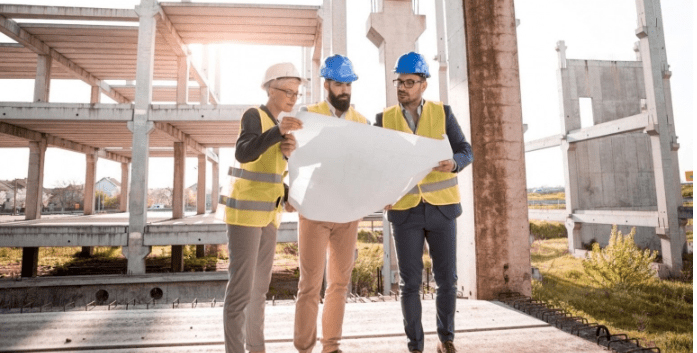
Do you want to know more about Construction Safety?
Construction safety is a critical aspect of the construction industry, aimed at ensuring the well-being of workers and the successful completion of projects. The construction environment is inherently hazardous, with various risks that can lead to accidents, injuries, and even fatalities if not properly managed. Implementing effective safety measures is essential to protect workers, reduce project delays, and comply with regulatory requirements.
This blog explores the importance of construction safety, common hazards, safety practices, and the role of technology in enhancing safety on construction sites.

Importance of Construction Safety
Construction safety is paramount for several reasons. First and foremost, it is about protecting human life. The construction industry accounts for a significant number of workplace injuries and fatalities each year. Ensuring a safe working environment helps to prevent accidents and save lives. Additionally, a strong safety culture enhances worker morale and productivity. When workers feel safe, they are more likely to be engaged and motivated, leading to higher efficiency and quality of work.
Moreover, construction safety is a legal requirement. Various regulations and standards, such as those set by the Occupational Safety and Health Administration (OSHA) in the United States, mandate strict adherence to safety protocols. Non-compliance can result in severe penalties, legal liabilities, and damage to a company's reputation. By prioritizing safety, construction companies can avoid these negative consequences and foster a positive reputation in the industry.
Common Hazards in Construction
Construction sites are fraught with numerous hazards that pose risks to workers. One of the most prevalent hazards is falls, which can occur from heights, scaffolding, ladders, and roofs. Falls often result in serious injuries or fatalities, making fall protection measures crucial. Another common hazard is being struck by objects, such as tools, equipment, or materials. This can happen due to improper handling, inadequate storage, or equipment malfunctions.
Electrocutions are also a significant risk, particularly when working near power lines or with electrical equipment. Proper insulation, grounding, and the use of personal protective equipment (PPE) are essential to mitigate this risk. Additionally, construction workers face the danger of being caught in or between machinery, structures, or materials. Ensuring that machinery is properly guarded and workers are trained in safe operating procedures can help prevent such incidents.
Safety Practices in Construction
Implementing robust safety practices is vital to mitigate risks and ensure a safe construction site. One of the fundamental practices is conducting thorough risk assessments before commencing any project. This involves identifying potential hazards, evaluating their severity, and implementing measures to control or eliminate them. Regular safety inspections and audits are also crucial to ensure ongoing compliance with safety standards and identify any emerging risks.
Training and education play a pivotal role in construction safety. Workers should receive comprehensive training on safety procedures, proper use of equipment, and emergency response protocols. Continuous education programs can keep workers updated on the latest safety practices and technologies. Additionally, fostering a culture of safety is essential. This can be achieved by encouraging workers to report hazards, promoting open communication, and recognizing and rewarding safe behaviors.
Personal protective equipment (PPE) is another critical component of construction safety. Depending on the nature of the work, PPE may include helmets, gloves, safety glasses, high-visibility clothing, and fall protection gear. Ensuring that PPE is readily available, properly maintained, and correctly used is vital to protecting workers from injuries.
Role of Technology in Enhancing Construction Safety
Advancements in technology have significantly contributed to improving construction safety. One notable innovation is the use of wearable technology, such as smart helmets and vests equipped with sensors. These devices can monitor workers' vital signs, detect hazardous conditions, and alert them to potential dangers. For instance, smart helmets can detect falls or impacts and automatically call for emergency assistance.
- Drones have also become valuable tools for enhancing safety on construction sites. They can be used for aerial inspections, surveying hazardous areas, and monitoring site conditions in real-time. Drones provide a safe and efficient way to gather data and identify potential hazards without putting workers at risk.
- Building Information Modeling (BIM) is another technological advancement that enhances construction safety. BIM allows for the creation of detailed digital models of construction projects, enabling better planning and visualization of safety measures. Potential hazards can be identified and addressed during the design phase, reducing the risk of accidents during construction.
- Moreover, the integration of artificial intelligence (AI) and machine learning can improve safety by predicting and preventing accidents. AI-powered systems can analyze vast amounts of data from various sources, such as safety reports, weather conditions, and equipment performance, to identify patterns and potential risks. Predictive analytics can then provide insights and recommendations to mitigate those risks.

Conclusions about Construction safety
Construction safety is a fundamental aspect of the construction industry, essential for protecting workers, ensuring project success, and complying with legal requirements. By understanding common hazards, implementing effective safety practices, and leveraging technological advancements, construction companies can create safer working environments and reduce the risk of accidents.
Prioritizing safety not only protects workers' lives but also enhances productivity, morale, and the overall reputation of construction firms. As technology continues to evolve, the future of construction safety looks promising, with innovative solutions paving the way for safer and more efficient construction processes.

